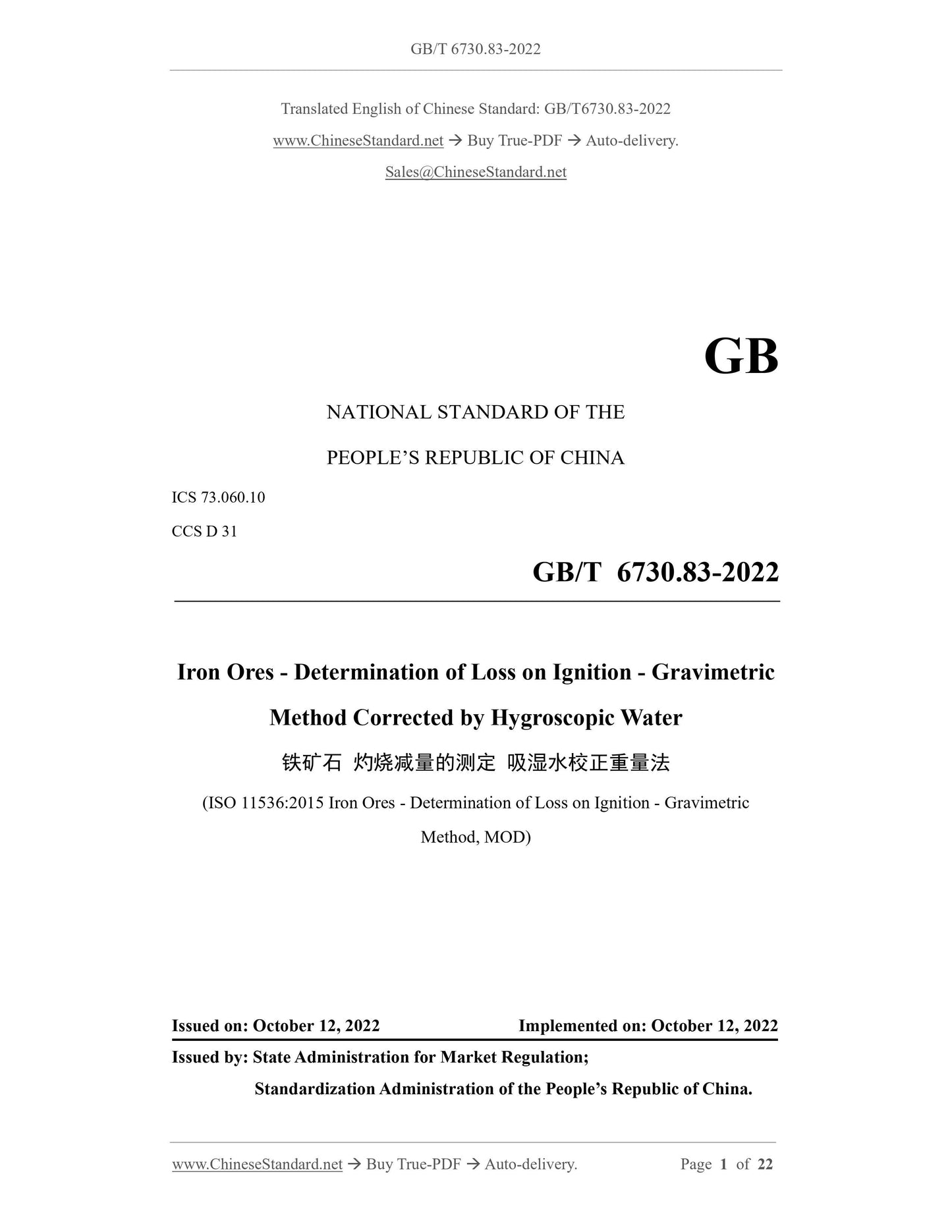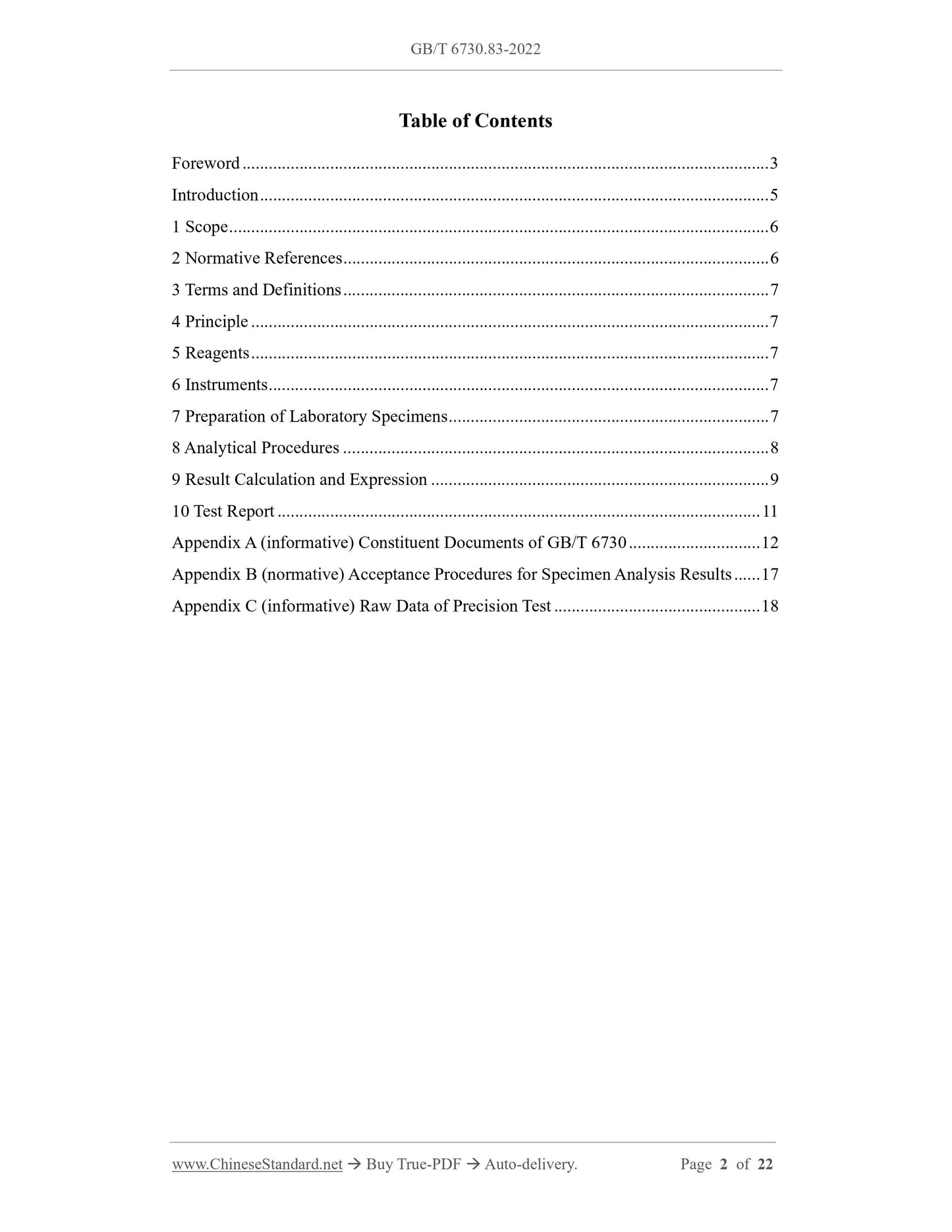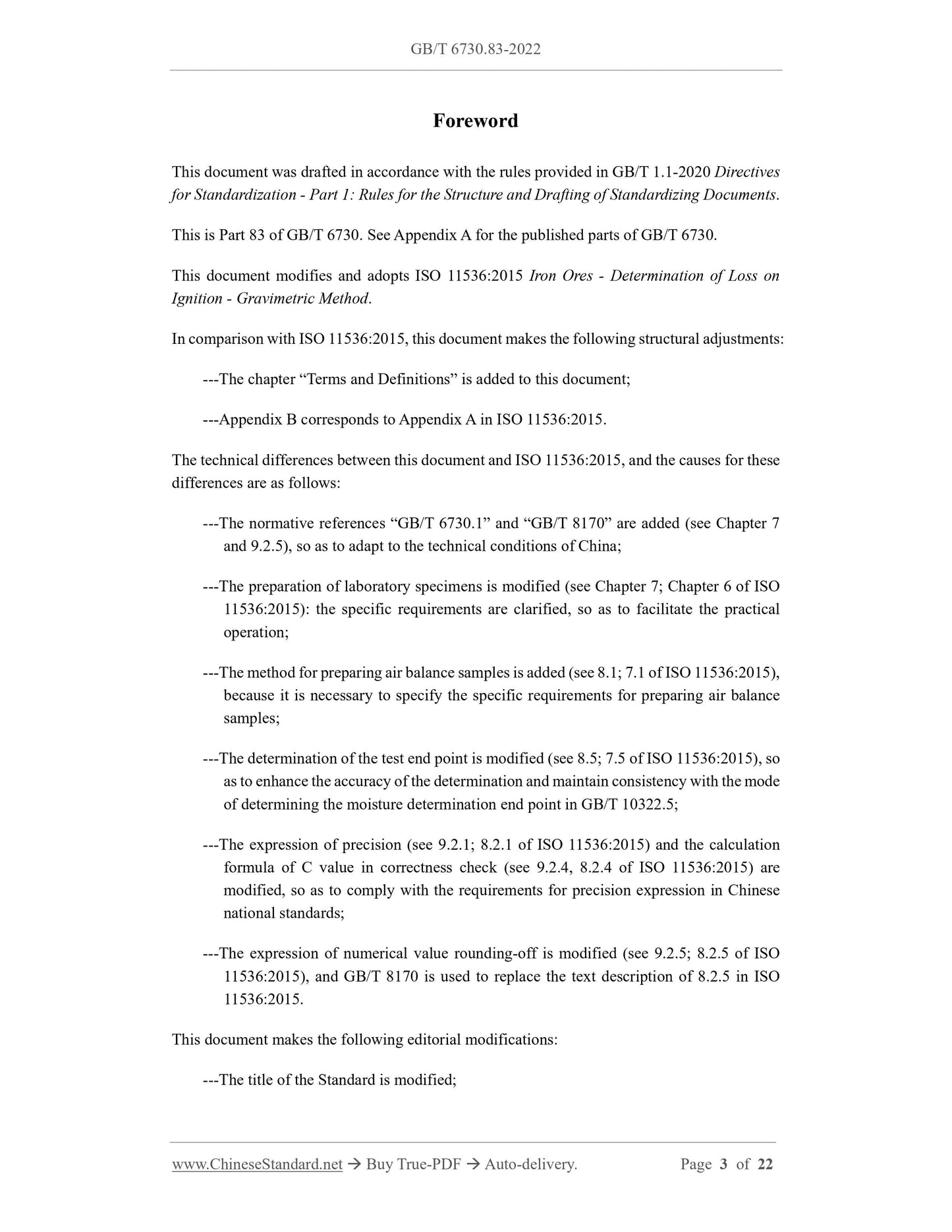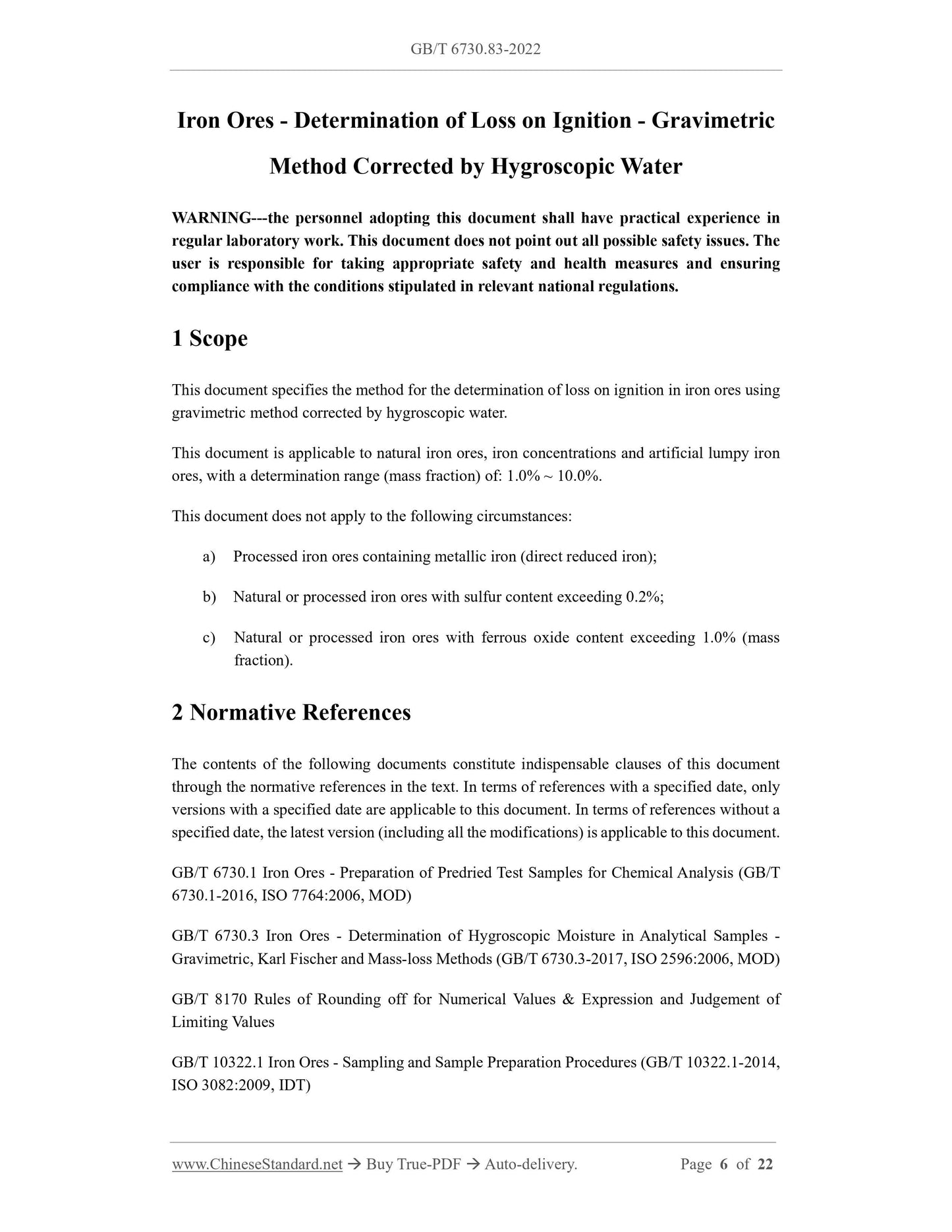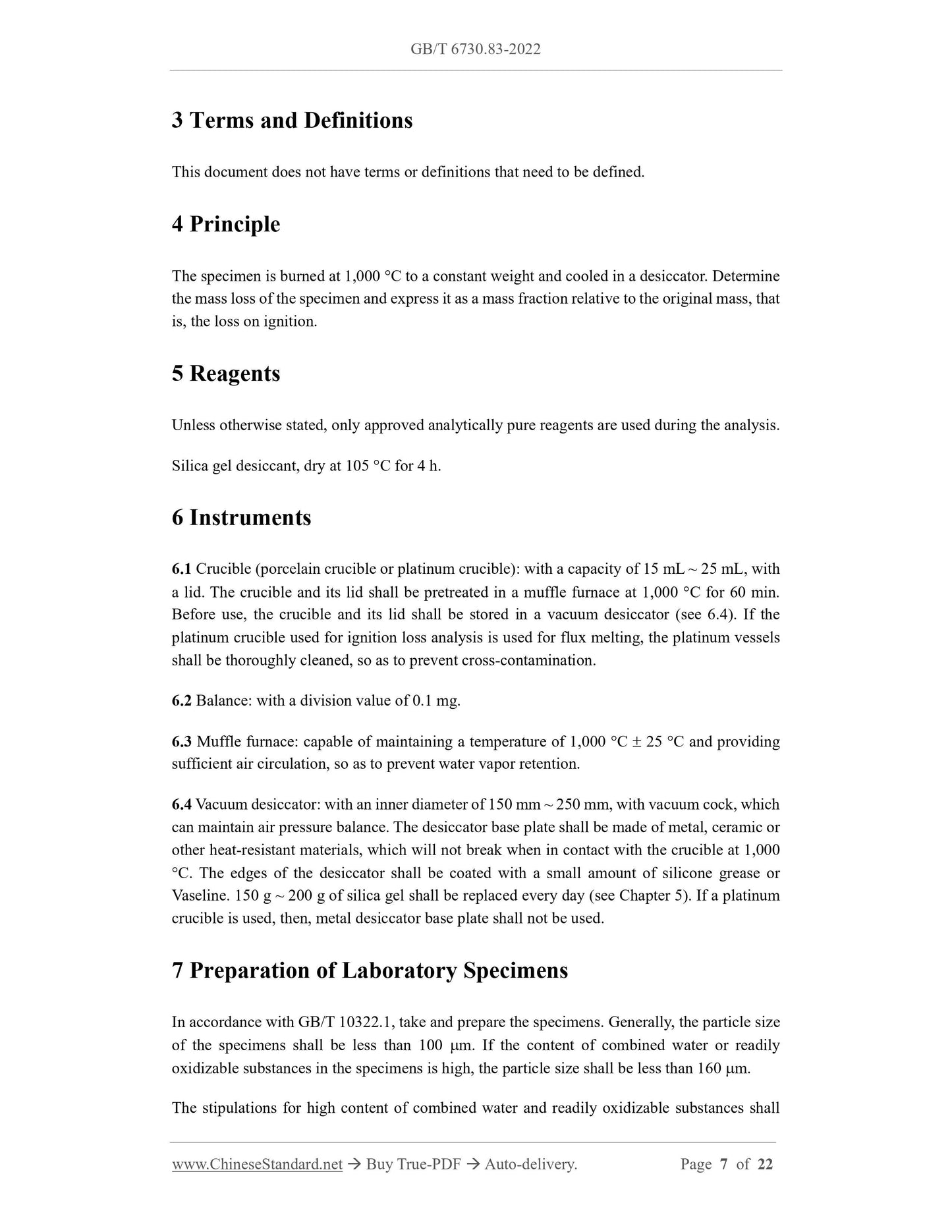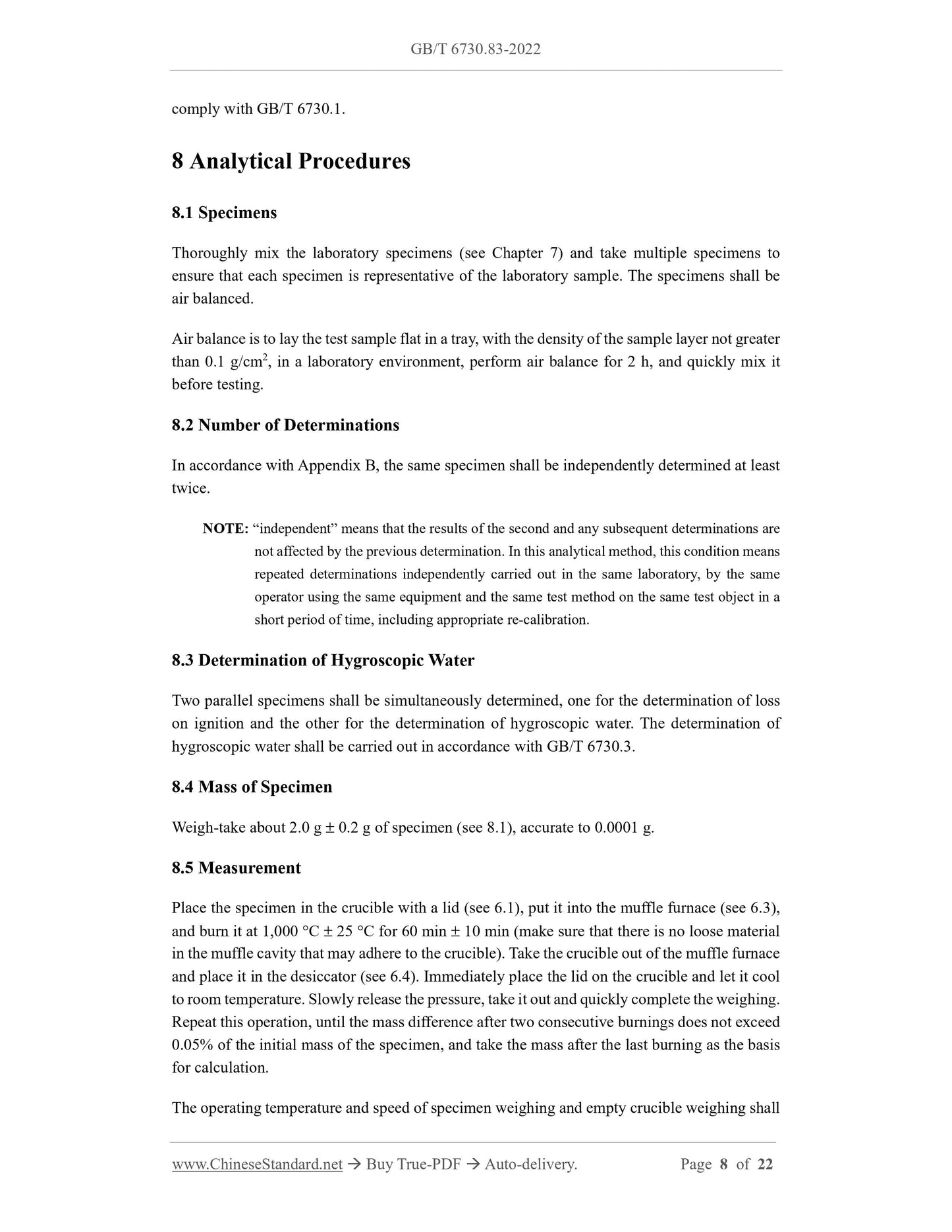1
/
of
6
PayPal, credit cards. Download editable-PDF and invoice in 1 second!
GB/T 6730.83-2022 English PDF (GBT6730.83-2022)
GB/T 6730.83-2022 English PDF (GBT6730.83-2022)
Regular price
$230.00 USD
Regular price
Sale price
$230.00 USD
Unit price
/
per
Shipping calculated at checkout.
Couldn't load pickup availability
Delivery: 3 seconds. Download true-PDF + Invoice.
Get QUOTATION in 1-minute: Click GB/T 6730.83-2022
Historical versions: GB/T 6730.83-2022
Preview True-PDF (Reload/Scroll if blank)
GB/T 6730.83-2022: Iron ores -- Determination of loss on ignition -- Gravimetric method corrected by hygroscopic water
GB/T 6730.83-2022
GB
NATIONAL STANDARD OF THE
PEOPLE’S REPUBLIC OF CHINA
ICS 73.060.10
CCS D 31
Iron Ores - Determination of Loss on Ignition - Gravimetric
Method Corrected by Hygroscopic Water
(ISO 11536:2015 Iron Ores - Determination of Loss on Ignition - Gravimetric
Method, MOD)
ISSUED ON: OCTOBER 12, 2022
IMPLEMENTED ON: OCTOBER 12, 2022
Issued by: State Administration for Market Regulation;
Standardization Administration of the People’s Republic of China.
Table of Contents
Foreword ... 3
Introduction ... 5
1 Scope ... 6
2 Normative References ... 6
3 Terms and Definitions ... 7
4 Principle ... 7
5 Reagents ... 7
6 Instruments ... 7
7 Preparation of Laboratory Specimens ... 7
8 Analytical Procedures ... 8
9 Result Calculation and Expression ... 9
10 Test Report ... 11
Appendix A (informative) Constituent Documents of GB/T 6730 ... 12
Appendix B (normative) Acceptance Procedures for Specimen Analysis Results ... 17
Appendix C (informative) Raw Data of Precision Test ... 18
Foreword
This document was drafted in accordance with the rules provided in GB/T 1.1-2020 Directives
for Standardization - Part 1: Rules for the Structure and Drafting of Standardizing Documents.
This is Part 83 of GB/T 6730. See Appendix A for the published parts of GB/T 6730.
This document modifies and adopts ISO 11536:2015 Iron Ores - Determination of Loss on
Ignition - Gravimetric Method.
In comparison with ISO 11536:2015, this document makes the following structural adjustments:
---The chapter “Terms and Definitions” is added to this document;
---Appendix B corresponds to Appendix A in ISO 11536:2015.
The technical differences between this document and ISO 11536:2015, and the causes for these
differences are as follows:
---The normative references “GB/T 6730.1” and “GB/T 8170” are added (see Chapter 7
and 9.2.5), so as to adapt to the technical conditions of China;
---The preparation of laboratory specimens is modified (see Chapter 7; Chapter 6 of ISO
11536:2015): the specific requirements are clarified, so as to facilitate the practical
operation;
---The method for preparing air balance samples is added (see 8.1; 7.1 of ISO 11536:2015),
because it is necessary to specify the specific requirements for preparing air balance
samples;
---The determination of the test end point is modified (see 8.5; 7.5 of ISO 11536:2015), so
as to enhance the accuracy of the determination and maintain consistency with the mode
of determining the moisture determination end point in GB/T 10322.5;
---The expression of precision (see 9.2.1; 8.2.1 of ISO 11536:2015) and the calculation
formula of C value in correctness check (see 9.2.4, 8.2.4 of ISO 11536:2015) are
modified, so as to comply with the requirements for precision expression in Chinese
national standards;
---The expression of numerical value rounding-off is modified (see 9.2.5; 8.2.5 of ISO
11536:2015), and GB/T 8170 is used to replace the text description of 8.2.5 in ISO
11536:2015.
This document makes the following editorial modifications:
---The title of the Standard is modified;
Iron Ores - Determination of Loss on Ignition - Gravimetric
Method Corrected by Hygroscopic Water
WARNING---the personnel adopting this document shall have practical experience in
regular laboratory work. This document does not point out all possible safety issues. The
user is responsible for taking appropriate safety and health measures and ensuring
compliance with the conditions stipulated in relevant national regulations.
1 Scope
This document specifies the method for the determination of loss on ignition in iron ores using
gravimetric method corrected by hygroscopic water.
This document is applicable to natural iron ores, iron concentrations and artificial lumpy iron
ores, with a determination range (mass fraction) of: 1.0% ~ 10.0%.
This document does not apply to the following circumstances:
a) Processed iron ores containing metallic iron (direct reduced iron);
b) Natural or processed iron ores with sulfur content exceeding 0.2%;
c) Natural or processed iron ores with ferrous oxide content exceeding 1.0% (mass
fraction).
2 Normative References
The contents of the following documents constitute indispensable clauses of this document
through the normative references in the text. In terms of references with a specified date, only
versions with a specified date are applicable to this document. In terms of references without a
specified date, the latest version (including all the modifications) is applicable to this document.
GB/T 6730.1 Iron Ores - Preparation of Predried Test Samples for Chemical Analysis (GB/T
6730.1-2016, ISO 7764:2006, MOD)
GB/T 6730.3 Iron Ores - Determination of Hygroscopic Moisture in Analytical Samples -
Gravimetric, Karl Fischer and Mass-loss Methods (GB/T 6730.3-2017, ISO 2596:2006, MOD)
GB/T 8170 Rules of Rounding off for Numerical Values and Expression and Judgement of
Limiting Values
GB/T 10322.1 Iron Ores - Sampling and Sample Preparation Procedures (GB/T 10322.1-2014,
ISO 3082:2009, IDT)
3 Terms and Definitions
This document does not have terms or definitions that need to be defined.
4 Principle
The specimen is burned at 1,000 C to a constant weight and cooled in a desiccator. Determine
the mass loss of the specimen and express it as a mass fraction relative to the original mass, that
is, the loss on ignition.
5 Reagents
Unless otherwise stated, only approved analytically pure reagents are used during the analysis.
Silica gel desiccant, dry at 105 C for 4 h.
6 Instruments
6.1 Crucible (porcelain crucible or platinum crucible): with a capacity of 15 mL ~ 25 mL, with
a lid. The crucible and its lid shall be pretreated in a muffle furnace at 1,000 C for 60 min.
Before use, the crucible and its lid shall be stored in a vacuum desiccator (see 6.4). If the
platinum crucible used for ignition loss analysis is used for flux melting, the platinum vessels
shall be thoroughly cleaned, so as to prevent cross-contamination.
6.2 Balance: with a division value of 0.1 mg.
6.3 Muffle furnace: capable of maintaining a temperature of 1,000 C 25 C and providing
sufficient air circulation, so as to prevent water vapor retention.
6.4 Vacuum desiccator: with an inner diameter of 150 mm ~ 250 mm, with vacuum cock, which
can maintain air pressure balance. The desiccator base plate shall be made of metal, ceramic or
other heat-resistant materials, which will not break when in contact with the crucible at 1,000
C. The edges of the desiccator shall be coated with a small amount of silicone grease or
Vaseline. 150 g ~ 200 g of silica gel shall be replaced every day (see Chapter 5). If a platinum
crucible is used, then, metal desiccator base plate shall not be used.
7 Preparation of Laboratory Specimens
In accordance with GB/T 10322.1, take and prepare the specimens. Generally, the particle size
of the specimens shall be less than 100 m. If the content of combined water or readily
oxidizable substances in the specimens is high, the particle size shall be less than 160 m.
The stipulations for high content of combined water and readily oxidizable substances shall
comply with GB/T 6730.1.
8 Analytical Procedures
8.1 Specimens
Thoroughly mix the laboratory specimens (see Chapter 7) and take multiple specimens to
ensure that each specimen is representative of the laboratory sample. The specimens shall be
air balanced.
Air balance is to l...
Get QUOTATION in 1-minute: Click GB/T 6730.83-2022
Historical versions: GB/T 6730.83-2022
Preview True-PDF (Reload/Scroll if blank)
GB/T 6730.83-2022: Iron ores -- Determination of loss on ignition -- Gravimetric method corrected by hygroscopic water
GB/T 6730.83-2022
GB
NATIONAL STANDARD OF THE
PEOPLE’S REPUBLIC OF CHINA
ICS 73.060.10
CCS D 31
Iron Ores - Determination of Loss on Ignition - Gravimetric
Method Corrected by Hygroscopic Water
(ISO 11536:2015 Iron Ores - Determination of Loss on Ignition - Gravimetric
Method, MOD)
ISSUED ON: OCTOBER 12, 2022
IMPLEMENTED ON: OCTOBER 12, 2022
Issued by: State Administration for Market Regulation;
Standardization Administration of the People’s Republic of China.
Table of Contents
Foreword ... 3
Introduction ... 5
1 Scope ... 6
2 Normative References ... 6
3 Terms and Definitions ... 7
4 Principle ... 7
5 Reagents ... 7
6 Instruments ... 7
7 Preparation of Laboratory Specimens ... 7
8 Analytical Procedures ... 8
9 Result Calculation and Expression ... 9
10 Test Report ... 11
Appendix A (informative) Constituent Documents of GB/T 6730 ... 12
Appendix B (normative) Acceptance Procedures for Specimen Analysis Results ... 17
Appendix C (informative) Raw Data of Precision Test ... 18
Foreword
This document was drafted in accordance with the rules provided in GB/T 1.1-2020 Directives
for Standardization - Part 1: Rules for the Structure and Drafting of Standardizing Documents.
This is Part 83 of GB/T 6730. See Appendix A for the published parts of GB/T 6730.
This document modifies and adopts ISO 11536:2015 Iron Ores - Determination of Loss on
Ignition - Gravimetric Method.
In comparison with ISO 11536:2015, this document makes the following structural adjustments:
---The chapter “Terms and Definitions” is added to this document;
---Appendix B corresponds to Appendix A in ISO 11536:2015.
The technical differences between this document and ISO 11536:2015, and the causes for these
differences are as follows:
---The normative references “GB/T 6730.1” and “GB/T 8170” are added (see Chapter 7
and 9.2.5), so as to adapt to the technical conditions of China;
---The preparation of laboratory specimens is modified (see Chapter 7; Chapter 6 of ISO
11536:2015): the specific requirements are clarified, so as to facilitate the practical
operation;
---The method for preparing air balance samples is added (see 8.1; 7.1 of ISO 11536:2015),
because it is necessary to specify the specific requirements for preparing air balance
samples;
---The determination of the test end point is modified (see 8.5; 7.5 of ISO 11536:2015), so
as to enhance the accuracy of the determination and maintain consistency with the mode
of determining the moisture determination end point in GB/T 10322.5;
---The expression of precision (see 9.2.1; 8.2.1 of ISO 11536:2015) and the calculation
formula of C value in correctness check (see 9.2.4, 8.2.4 of ISO 11536:2015) are
modified, so as to comply with the requirements for precision expression in Chinese
national standards;
---The expression of numerical value rounding-off is modified (see 9.2.5; 8.2.5 of ISO
11536:2015), and GB/T 8170 is used to replace the text description of 8.2.5 in ISO
11536:2015.
This document makes the following editorial modifications:
---The title of the Standard is modified;
Iron Ores - Determination of Loss on Ignition - Gravimetric
Method Corrected by Hygroscopic Water
WARNING---the personnel adopting this document shall have practical experience in
regular laboratory work. This document does not point out all possible safety issues. The
user is responsible for taking appropriate safety and health measures and ensuring
compliance with the conditions stipulated in relevant national regulations.
1 Scope
This document specifies the method for the determination of loss on ignition in iron ores using
gravimetric method corrected by hygroscopic water.
This document is applicable to natural iron ores, iron concentrations and artificial lumpy iron
ores, with a determination range (mass fraction) of: 1.0% ~ 10.0%.
This document does not apply to the following circumstances:
a) Processed iron ores containing metallic iron (direct reduced iron);
b) Natural or processed iron ores with sulfur content exceeding 0.2%;
c) Natural or processed iron ores with ferrous oxide content exceeding 1.0% (mass
fraction).
2 Normative References
The contents of the following documents constitute indispensable clauses of this document
through the normative references in the text. In terms of references with a specified date, only
versions with a specified date are applicable to this document. In terms of references without a
specified date, the latest version (including all the modifications) is applicable to this document.
GB/T 6730.1 Iron Ores - Preparation of Predried Test Samples for Chemical Analysis (GB/T
6730.1-2016, ISO 7764:2006, MOD)
GB/T 6730.3 Iron Ores - Determination of Hygroscopic Moisture in Analytical Samples -
Gravimetric, Karl Fischer and Mass-loss Methods (GB/T 6730.3-2017, ISO 2596:2006, MOD)
GB/T 8170 Rules of Rounding off for Numerical Values and Expression and Judgement of
Limiting Values
GB/T 10322.1 Iron Ores - Sampling and Sample Preparation Procedures (GB/T 10322.1-2014,
ISO 3082:2009, IDT)
3 Terms and Definitions
This document does not have terms or definitions that need to be defined.
4 Principle
The specimen is burned at 1,000 C to a constant weight and cooled in a desiccator. Determine
the mass loss of the specimen and express it as a mass fraction relative to the original mass, that
is, the loss on ignition.
5 Reagents
Unless otherwise stated, only approved analytically pure reagents are used during the analysis.
Silica gel desiccant, dry at 105 C for 4 h.
6 Instruments
6.1 Crucible (porcelain crucible or platinum crucible): with a capacity of 15 mL ~ 25 mL, with
a lid. The crucible and its lid shall be pretreated in a muffle furnace at 1,000 C for 60 min.
Before use, the crucible and its lid shall be stored in a vacuum desiccator (see 6.4). If the
platinum crucible used for ignition loss analysis is used for flux melting, the platinum vessels
shall be thoroughly cleaned, so as to prevent cross-contamination.
6.2 Balance: with a division value of 0.1 mg.
6.3 Muffle furnace: capable of maintaining a temperature of 1,000 C 25 C and providing
sufficient air circulation, so as to prevent water vapor retention.
6.4 Vacuum desiccator: with an inner diameter of 150 mm ~ 250 mm, with vacuum cock, which
can maintain air pressure balance. The desiccator base plate shall be made of metal, ceramic or
other heat-resistant materials, which will not break when in contact with the crucible at 1,000
C. The edges of the desiccator shall be coated with a small amount of silicone grease or
Vaseline. 150 g ~ 200 g of silica gel shall be replaced every day (see Chapter 5). If a platinum
crucible is used, then, metal desiccator base plate shall not be used.
7 Preparation of Laboratory Specimens
In accordance with GB/T 10322.1, take and prepare the specimens. Generally, the particle size
of the specimens shall be less than 100 m. If the content of combined water or readily
oxidizable substances in the specimens is high, the particle size shall be less than 160 m.
The stipulations for high content of combined water and readily oxidizable substances shall
comply with GB/T 6730.1.
8 Analytical Procedures
8.1 Specimens
Thoroughly mix the laboratory specimens (see Chapter 7) and take multiple specimens to
ensure that each specimen is representative of the laboratory sample. The specimens shall be
air balanced.
Air balance is to l...
Share
